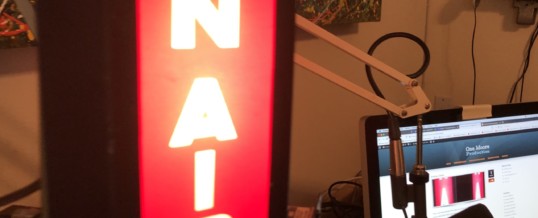
Photo: John Moore was given the original on-air light during a remodel of a country radio station where he worked as a DJ in the 1980s and 90s – the last era of real country music, according to Moore.
The old joke when I worked as a country music DJ was that our station played both kinds of music – Country and Western.
But today, I don’t even recognize what’s called, “Country Music.”
Every “country” song I hear now has virtually the same lyrics about tailgates, dirt roads, drinking heavily, and some girl keying her boyfriend’s truck (almost always, the same truck whose tailgate was mentioned earlier in the song).
The worst part of today’s alleged country music is that some artists include rap music in their songs.
If you don’t know what rap music is, first, I’d recommend saying a little prayer of thanks that you don’t, and second, “Rap Music” is an oxymoron.
And it doesn’t belong in country music.
Country enjoyed great popularity from the 1940s through the early 1970s. But, by the time I got my first radio job in the late 1970s, it had become the redheaded stepchild of music formats. Top 40 and rock music on the FM dial had taken over in the ratings.
In my opinion, Willie Nelson was the Redheaded Stranger who helped lead the effort to bring it out of the stereotype under which it had found itself. His groundbreaking albums of the mid-to-late 70s led to a resurgence of country by the early 80s.
The DJs and record companies at the time, who fed from both the Top 40 and rock music troughs, looked down their noses at and even mocked country artists and the radio stations that played their music.
The argument against country music was that it was just a handful of chords, overlapped with lyrics about people looking at their own crumbling world through the bottom of a bottle or glass.
To some degree, these statements were based on truths. But country music fans liked the songs and bought the albums because they could identify with them. Many of the fans were going through what the artists were singing about.
Country fans really were losing their husbands or wives; their kids; and often, also their homes, trucks and dogs.
During the 1970s, Top 40, rock music, and disco dominated the radio ratings and record sales.
But country music pretty much held on to its, “Three chords and the truth,” formula, as country songwriter Harlan Howard said it best, back in the 1950s.
In the early 70s, The Eagles and other southern bands introduced “Country Rock.” It was these bands and their flavor of writing and performing that exposed a new generation to country music.
It stuck during the rest of the 70s, which led to a country music awakening in the early 80s with the release of the film and soundtrack, Urban Cowboy.
During the late 80s and early 90s, country music became the biggest format in radio. Country stations’ ratings went through the roof and the sales of country music exploded.
The same record company executives, who just a few years before were looking down their noses at Loretta Lynn and Mickey Gilley, were now trying to be best friends with newcomers such as George Strait, Garth Brooks, Trisha Yearwood, and Clint Black.
These new singers mixed some of their early influencers like the Eagles and Marshall Tucker Band, while Randy Travis and Dwight Yoakum had hits by embracing more traditional country influences, such as Hank Williams and Buck Owens.
The older country music resonated with fans because it was pure.
When Loretta Lynn sang that, “You Ain’t Woman Enough To Take My Man,” you believed her. I have no doubt that Loretta would have had no problem asking another woman to, “Take this outside.”
The rock artists of the time, wearing their sparkly outfits and eye makeup, seemed more like that kid in 8th grade gym class who got a wedgie every day and was beat up at least once a week.
Country Music artists looked and acted like real people – because they were. But, today, I’m just not sure what I’m seeing and hearing. Artists still wear boots and hats, but the tunes are quite different.
Not all of the new country acts are rapping in their songs. Many of today’s country music artists are writing and singing in ways that are closer to the roots of the country music that many of us grew up with. And that gives me hope.
People’s tastes are cyclical, and consequently, so is music. I’m just hoping that we’re close to cycling away from rap. I’m ready to go back to Luckenbach, Texas, with Waylon, Willie, and the boys.
©2020 John Moore
John’s book, Write of Passage: A Southerner’s View of Then and Now, and his new book, Write of Passage Volume II, are available on Amazon and on John’s website at www.TheCountryWriter.com.
MAR
2020
